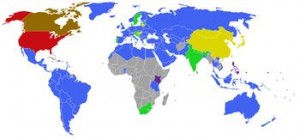 When I think of American exceptionalism, I don’t think of grand political theories. Instead, I think of how the U.S. is one of only five countries that uses the Farenheit scale for everyday applications (the others being the Bahamas, Belize, the Cayman Islands, and Palau).
When I think of American exceptionalism, I don’t think of grand political theories. Instead, I think of how the U.S. is one of only five countries that uses the Farenheit scale for everyday applications (the others being the Bahamas, Belize, the Cayman Islands, and Palau).
Even more exceptional is the fact that the U.S. is the only country to state dates using the mm-dd-yyyy format. That’s why we’re the only country in red in the map to the right. Go here for ruminations about this on Reddit.
This sort of exceptionalism seems unhelpful. For one thing, it can create confusion: when it comes to dates, 10/6/15 could mean October 6, 2015 (US) or 10 June 2015 (elsewhere).
If you have the urge to strike a blow for rationality, you could start using in contracts and elsewhere the format dd-mm-yyyy, which is used by the countries in blue in the map. If you state the month as a word instead of a number, no confusion would be possible, so no one would have a good reason to object. (Mind you, for some people, lack of a good reason wouldn’t be an obstacle.)
I might make this change for my personal use.

The sensible way of doing it is yyyy-mm-dd, so that today is 2015-11-01. That allows easy computer sorting (and is how I do it for personal use).
It’s comforting that I’m not the only seditious person out there!
But as regards “sensible,” I can conceive of countervailing considerations. If someone’s telling me when they’re arriving for a visit, presumably the day and, secondarily, the month are more likely to be at issue, as opposed to the year, so why not put that information first?
And your format is perhaps a bit hard core to use in regular prose.
How is 2015-11-02 any more or less hardcore than 11/2/2015?
The more interesting question is whether we would sufficiently get on that ISO standard that we could write 2015-11-02 in a contract instead of November 2, 2015, and of course, either is better than “this 2nd day of November, 2015.”
For contracts, the “November 2, 2015” version seems likely to persist for a long while to avoid the potential confusion for US parties. Nonstandard and clear is better than standard but confusing (until the standard catches on).
See my response to A. Wright Burke. And you can avoid confusion just as effectively with the format 2 November 2015.
This is, in fact, how they do it in Hungary. Exceptionalism indeed!
Seriously, for contract drafting purposes, best solution is to spell out the month; out of your difficulty at once. Just don’t give me one dated 17th Brumaire.
D.C.:
I use the same in revision numbers (without the dashes, and with a letter at the end to distinguish revisions of the same date). But I wouldn’t use that in a document because it is unusual and open to misinterpretation for many dates.
Chris
A few comments:
1/ ISO 8601
2/ D.C. is right: 2015-11-01 rules.
But I would usually add a weekday indicator as a control against error, so 2015-11-01-U, where “U” stands for Sunday in the MTWRFAU series. The trouble with those weekday indicators is that they use bits of the English day names, which is parochial. Using a single-digit numeral would solve that problem but make the date confusing to follow: 2015-11-10-7. So dump the weekday indicator when it makes trouble.
3/ A less good, but still clear, way to state dates is any variation of day/month/year with the month in a non-numerical format (counting Roman numerals as non-numerical). Examples:
01.xi.2015
01.xi.015
01 November 2015
01-Nov-015
But why consider the rest when you’ve seen the best?
ISO date is indeed one of my autotext fills, 2015-11-02.
I idiosyncratically prefer the #3 version using 2-Nov-15 in emails, checks, and so on, with the source, I recall, being what I learned as one of the Army ways of doing things.
But isn’t 16-Nov-15 ambiguous between dd/month/yy and yy/month/dd? Better add a third digit to make yyy: 16-Nov-015.
Yikes!
I think you and others misunderstand the function of ISO 8601. It’s for the exchange of data. It’s not for stating dates in documents. For that purpose, it’s not clear enough, as the numbers-only format permits month-or-day confusion. The reader has no way of knowing what convention you’re following. That’s why it’s best to spell out the month.
You’re right, of course. Contracts are prose, and prose calls for words. I think your starting point in this blog post was to use a word for the month and thereby banish uncertainty. But all the talk of ‘in contracts and elsewhere’ and ‘for my personal use’ (in drafting contracts or elsewhere?) fuzzed the issue. Maybe a moderate rule is this:
1/ In contracts, use the format November 4, 2015 absent reason to use a different format.
2/ If a different format would be unertain, for example between 11/04/2015 and 04/11/2015, banish uncertainty with a concise internal rule of interpretation, either on-site at first occurrence or in a ‘construction’ section: ‘numerical dates use the format dd/mm/yyyy’ (or whatever format you are using).
3/ Finally, never send Vance Koven a contract dated ’17th Brumaire’. He hates that. Wait a day and date it ’18th Brumaire’.